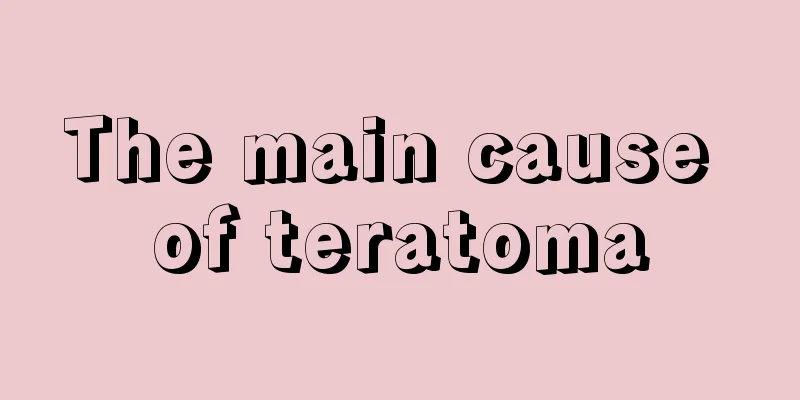The main cause of teratoma

|
When it comes to teratoma, I believe you will definitely show an expression that you have never heard of it. After all, this is a disease that is not very common in life. Experts say that teratoma deteriorates quickly, and we should go to the hospital for treatment as soon as we find it. So, what are the main causes of teratoma? Let me introduce it to you below. 1. Causes of teratoma: During the embryonic period, some tissues or cells with omnipotent development potential escape the control of tissue origin and inducer, separate or fall off from the whole, mix in the individual, cause cell gene mutation and lead to abnormal differentiation, and develop into teratoma; if it happens in the late embryonic period, the cells still have the ability to develop into various tissues of the body, that is, form a teratoma with three germ layer tissues: inner, middle and outer. The tail Hen-Son node is the place where pluripotent cells are concentrated, so sacrococcygeal teratoma is the most common. Keith reported: Parents with teratoma can pass it on to the next generation. In 6 families, 17 people suffered from sacrococcygeal teratoma, and both men and women can get sick, suggesting that the occurrence of sacrococcygeal teratoma is related to genetics. 2. Pathology of teratoma: Teratomas are composed of several different types of tissues from 2 or 3 germ layers, so they can contain every type of tissue in the body. The site of occurrence is closely connected to the midline anterior or para-midline area of the viviparous body cavity, such as the sacrum, mediastinum, retroperitoneum, and ovaries and testicles. According to the degree of tissue maturity, teratomas can be divided into benign teratomas, malignant teratomas, and mixed teratomas. Teratomas have a tendency to become malignant. As children age, the rate of malignancy gradually increases, especially sacrococcygeal teratomas, which can become malignant within a short period of time after birth. However, there are also malignant teratomas at the onset. Malignant teratomas grow rapidly, easily penetrate the capsule and invade surrounding tissues, and metastasize to lymph nodes, lungs, and bone tissues through lymphatic and blood circulation. Generally, most cystic teratomas are benign. There are more malignant solid tumors. Histological grading of teratomas helps to determine prognosis and guide treatment. Grade 0 or 1 teratomas have a lower chance of becoming malignant and most do not metastasize. Grade 3 teratomas have the greatest chance of becoming malignant. 3. There are several main causes of disease: 1. Compression: The huge benign ovarian cyst fills the entire abdominal cavity, increasing the intra-abdominal pressure and affecting the venous return of the lower limbs, which can lead to edema of the abdominal wall and bilateral lower limbs. 2. Lower abdominal pain: If the tumor has no complications, the patient rarely experiences pain. If there is pain, it is definitely due to the torsion of the tumor pedicle, or occasionally due to tumor rupture, bleeding or infection. 3. Unexplained discomfort in the lower abdomen: Due to the weight of the tumor itself and the influence of intestinal peristalsis and changes in body position, the tumor moves in the pelvic cavity, involving its pedicle and pelvic infundibulum ligament, causing the patient to have a feeling of fullness and falling in the lower abdomen or iliac fossa. Once a teratoma is diagnosed, early surgical resection is necessary to prevent the malignant transformation of benign teratoma due to delayed surgery, and to prevent infection, rupture, bleeding and complications. The key point of teratoma surgery is to completely remove the tumor (a tumor is an abnormal lesion formed by the loss of normal regulation of the growth of a cell in a local tissue at the genetic level under the action of various carcinogenic factors, resulting in its clonal abnormal proliferation). For ovarian and testicular tumors, one ovary or testicle is removed. For sacrococcygeal teratoma, it is emphasized that the coccyx must be removed at the same time to avoid residual pluripotent cells and cause tumor recurrence. The above is an explanation of the causes of teratoma, I hope it will be helpful to you. Experts suggest that we should not be afraid of this disease, because fear cannot solve any problems. Only by being strong and actively fighting the disease can we regain our health. |
<<: What are the causes of mediastinal teratoma
>>: Gynecologist explains the causes of teratoma
Recommend
How should anal fistula be treated surgically?
Anal fistula, also known as anorectal fistula, is...
What to do if your neck becomes oily
Oily skin is a type of skin that only a small num...
Walk more to prevent dementia and delay aging
A recent long-term survey showed that people who ...
If you have these 5 habits when you wake up in the morning, you will definitely die earlier than others
When you wake up from sleep, get up, eat, exercis...
How to treat angular cheilitis
We may encounter various diseases in our daily li...
How much weight is normal during two months of pregnancy
Normal women will inevitably gain weight during p...
Analysis of why shoulder pain occurs when it is cold
Some friends will find pain in their shoulders wh...
What is the most environmentally friendly way to repel mosquitoes?
What I hate most in summer are mosquitoes. Their ...
What should patients with advanced liver cancer eat? A complete recipe for advanced liver cancer
The liver is the most important digestive organ i...
What to do if my legs become numb while sleeping on the table
In daily life, many people often sleep on the tab...
Organic cosmetics
Cosmetics are very common and there are many type...
Why does my stomach become hard?
Pregnant women may have bigger and bigger stomach...
Is it okay to eat eggs if you have gastroenteritis? What are the taboos?
Gastroenteritis has become more and more common i...
What factors affect the survival rate of mid-to-late stage prostate cancer
Many men have the habit of smoking, which will in...
Is kidney deficiency the cause of lower back pain in men?
In life, many men often feel back pain, and have ...









